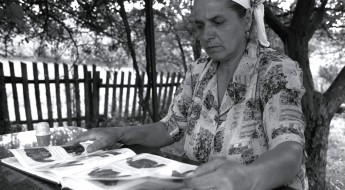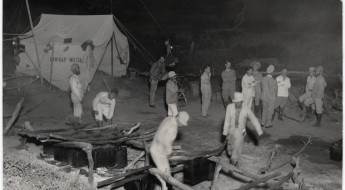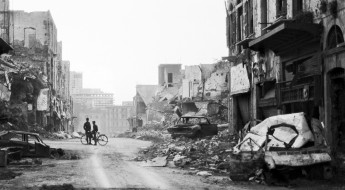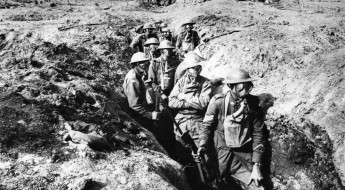From our archives: Modes of transport
 1914-1918 war. Near the front, in a Hungarian Red Cross ambulance car, the wounded are taken in and given first aid before being evacuated.© ICRC Photo Library / hist-e-00402
1914-1918 war. Near the front, in a Hungarian Red Cross ambulance car, the wounded are taken in and given first aid before being evacuated.© ICRC Photo Library / hist-e-00402 Famine in Russia, 1921-1923. A joint relief operation was carried out by a number of organizations, including the ICRC. Here, food aid is being transported, from a railway station to the communal kitchens, on carts pulled by camels.© ICRC Photo Library / hist-02591-12A
Famine in Russia, 1921-1923. A joint relief operation was carried out by a number of organizations, including the ICRC. Here, food aid is being transported, from a railway station to the communal kitchens, on carts pulled by camels.© ICRC Photo Library / hist-02591-12A Spanish Civil War. Geneva, 1938. A convoy of Swiss Red Cross buses leaves for Madrid. They were to evacuate civilians trapped in the city, which was being bombed by the nationalist air force.© ICRC Photo Library / hist-01860-26
Spanish Civil War. Geneva, 1938. A convoy of Swiss Red Cross buses leaves for Madrid. They were to evacuate civilians trapped in the city, which was being bombed by the nationalist air force.© ICRC Photo Library / hist-01860-26 1939-1945 war. In the warehouse at Plainpalais, Geneva, lorries are loaded with parcels for prisoners of war in Germany.© ICRC Photo Library / hist-03264-31a
1939-1945 war. In the warehouse at Plainpalais, Geneva, lorries are loaded with parcels for prisoners of war in Germany.© ICRC Photo Library / hist-03264-31a From Beirut to Haifa, 1949. This 300-tonne sailing ship, with its auxiliary engine, was chartered by the ICRC to bring supplies to the Palestinians in Israel.© ICRC / ps-n-00043-53
From Beirut to Haifa, 1949. This 300-tonne sailing ship, with its auxiliary engine, was chartered by the ICRC to bring supplies to the Palestinians in Israel.© ICRC / ps-n-00043-53 Golan, 1972. Buses are used for an exchange of civilian groups between Israel and Syria.© ICRC / Marzorati / ilaa-e-00006
Golan, 1972. Buses are used for an exchange of civilian groups between Israel and Syria.© ICRC / Marzorati / ilaa-e-00006 Badakhshan, north-eastern Afghanistan, 1989. An ICRC team during a two-month mission in the northern provinces.© ICRC / C. Piralla / af-d-00021-12
Badakhshan, north-eastern Afghanistan, 1989. An ICRC team during a two-month mission in the northern provinces.© ICRC / C. Piralla / af-d-00021-12 Grozny, Chechnya, 1995. Tankers transport drinking water for distribution to the local people.© ICRC / E. Bouvet / ru-d-00007-06
Grozny, Chechnya, 1995. Tankers transport drinking water for distribution to the local people.© ICRC / E. Bouvet / ru-d-00007-06 Gode, Ethiopia, 2000. In April and May 2000, 4,500 tonnes of relief supplies were transported by plane from Nairobi to Gode, and then on by lorry to villages affected by drought and famine.© ICRC / T. Mayer / et-n-00232-04
Gode, Ethiopia, 2000. In April and May 2000, 4,500 tonnes of relief supplies were transported by plane from Nairobi to Gode, and then on by lorry to villages affected by drought and famine.© ICRC / T. Mayer / et-n-00232-04 Democratic Republic of the Congo, 2003. In some cases, the most suitable form of transport is a bicycle. This volunteer from the DRC Red Cross collects and distributes Red Cross messages in the suburbs of Moba, Katanga Province. The purpose of these messages is to restore links between Congolese people and their relatives who have taken refuge in neighbouring countries.© ICRC / W. Lembryk / cd-e-00575
Democratic Republic of the Congo, 2003. In some cases, the most suitable form of transport is a bicycle. This volunteer from the DRC Red Cross collects and distributes Red Cross messages in the suburbs of Moba, Katanga Province. The purpose of these messages is to restore links between Congolese people and their relatives who have taken refuge in neighbouring countries.© ICRC / W. Lembryk / cd-e-00575 Democratic Republic of the Congo, Kindu, 2004. For longer trips, a motorbike is a better option. These two ICRC employees are setting off for Munyengo, a village 30 kilometres away.© ICRC / Agence O Globo / cd-e-00302
Democratic Republic of the Congo, Kindu, 2004. For longer trips, a motorbike is a better option. These two ICRC employees are setting off for Munyengo, a village 30 kilometres away.© ICRC / Agence O Globo / cd-e-00302 Pakistan, 2005. After the terrible earthquake in 2005, roads in the affected region were impassable. A helicopter made it possible to transport the wounded and, as in this photo, to bring food and other vital necessities to the people living there.© ICRC / F. Clarke / pk-e-00230
Pakistan, 2005. After the terrible earthquake in 2005, roads in the affected region were impassable. A helicopter made it possible to transport the wounded and, as in this photo, to bring food and other vital necessities to the people living there.© ICRC / F. Clarke / pk-e-00230 Lebanon War, 2006. The ICRC ship the Georgios K., arriving from Cyprus, being unloaded in Beirut. It was carrying five Landcruisers, food rations to feed 100,000 families for a week, and other essential items.© ICRC / M. Kokic / lb-e-00066
Lebanon War, 2006. The ICRC ship the Georgios K., arriving from Cyprus, being unloaded in Beirut. It was carrying five Landcruisers, food rations to feed 100,000 families for a week, and other essential items.© ICRC / M. Kokic / lb-e-00066 Nariño, Colombia, 2010. Doctors and nurses from the ICRC, the medical mission and the department of health travel from Negrito to Barbacoas in dugout canoes, to bring health care to the people living in these isolated areas.© ICRC / C. von Toggenburg / co-e-00957
Nariño, Colombia, 2010. Doctors and nurses from the ICRC, the medical mission and the department of health travel from Negrito to Barbacoas in dugout canoes, to bring health care to the people living in these isolated areas.© ICRC / C. von Toggenburg / co-e-00957 Syria, 2013. ICRC and Syrian Arab Red Crescent convoy on their way to rural Deir Ezzor.© ICRC / L. Khalil
Syria, 2013. ICRC and Syrian Arab Red Crescent convoy on their way to rural Deir Ezzor.© ICRC / L. Khalil
This series of photos illustrates the diversity of the means of transport used, now and in the past, to enable the ICRC and the National Red Cross and Red Crescent Societies to do their humanitarian work. Whether it be to evacuate people who are wounded or in danger, reach those in need, or bring them assistance, logistics are vital to how we organize our operations.




